Lofts on Ludington
New Urbanism in a Traditional Downtown Neighborhood
Location: Escanaba, Michigan
Population: 12,616
A column by Caroline Weber Kennedy
This story is a good one for all the right reasons. It begins well, ends well, and contains challenges, tragedy, and perseverance. The Richter Brewery building isn’t fancy—it’s one of those fine architectural structures you notice whether you’re local or from out of town. Placed on the National Register of Historic Places in 2009, the Richter Brewery Company built the brewery in 1901, with the addition of an office building in 1915. After promising beginnings, the brewery was closed due to Prohibition (the challenge), and sold in 1925 to the Delta Brewery Company, which manufactured non-alcoholic beverages until Prohibition’s end, and once again brewed beer until bankruptcy closed its doors in 1940 (the tragedy). The brewery building carries the Delta moniker, while the adjacent office building carries the original Richter name.
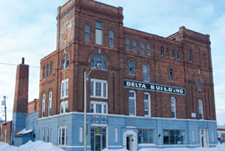 |
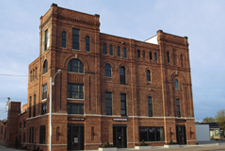 |
Primarily vacant over the years and growing ever more forlorn, it was Escanaba’s homegrown designer Matt Sviland who in 2008 harnessed his talent to the brewery’s potential, and with unassailable passion developed a vision to repurpose the Escanaba landmark.
Principles on New Urbanism
The Lofts on Ludington project demonstrates many of the positives of “the new urbanism” discipline of city planning and design, complemented by the redevelopment of an historical building, in a small city with traditional neighborhood design. (For more on new urbanism, visit newurbanism.org). This project is a mixed-used redevelopment that preserves and highlights many aspects of the original Richter Brewery’s historic charm and significance, sealing its place as a nostalgic and beloved landmark, and enhancing Escanaba’s downtown in many respects.
Mixed Use and Income
Two hallmarks of new urbanism at work here are the mix of both residential and commercial uses in the same building, along with tenants of mixed income. Of the 15 apartments, eight are designated as affordable housing, while the remainder command market rate. This is important, as too many communities have developed neighborhoods segregated by income. And what a sweet retreat these lofts are! Ceilings are 12-18 feet high, walls are exposed brick, and the historically accurate windows are energy efficient. The interior bricks are sandblasted so smooth they appear as clean as if they were freshly plucked from the Lake Michigan surf, a few blocks away. Stairs are recycled floor joists of virgin Douglas fir, the floors are stained concrete, and some units offer outdoor living space. Sviland handled the sandblasting, staining, and color choices throughout. His passion, dedication, and talent truly shine.
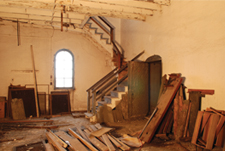 |
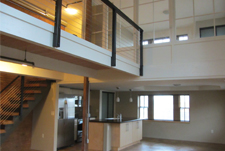 |
| Escanaba’s homegrown designer Matt Sviland repurposed a downtown landmark to include residential and commercial use, with eight units designated as affordable housing. |
The three street-level commercial units facing Ludington include Salon West and Spa providing hair styling, manicures, pedicures, and massages in an upscale relaxed atmosphere, to which you may have your lunch or treats delivered by nearby Stone’s Deli (yum); Pink Sugar Co., a unique and trendy women’s and children’s clothing and gift shop; and the services and works of the talented Holly Nicholson-Nylund Photography. All three businesses generate daytime traffic in complement to one another.
Safety and Walkability
Another hallmark of new urbanism—this mixed-use space provides a 24/7 presence due to the differing hours of business traffic and residents. Business is active when residents are out and about. Residents in turn, provide the “lighted window” effect, which is arguably the most effective safety feature of any downtown neighborhood, whether the presence is real or perceived.
Another key component of new urbanism in this project is walkability. We hear a lot about it, but let’s examine this a moment. The Lofts commercial space is a walkable destination for many in Escanaba’s traditional neighborhoods, while residents of the Lofts can walk to restaurants, entertainment venues, a grocery store, and many other necessities and amenities. The Lofts are about a dozen blocks from the Bonafis Fine Arts Center, other civic and government services, and Escanaba’s picturesque harbor, public beach, and park lands.
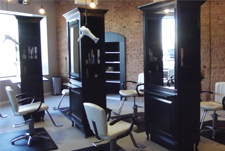 |
| The street level commercial units include a salon and spa, a clothing store and gift shop, and a photography studio. |
Walkable urban places are in high demand by both of America’s largest generations—the Baby Boomers (83 million) and the Millennials (78 million). Walkability decreases dependence on automobiles and foreign oil, while correspondingly increasing the affordability of the living location; it extends independence for the aging population and promotes independence and responsibility among adolescents. Walking contributes to the health of all, as well as generating activity and social interaction among all segments of the population within the community.
All of these factors contribute to the success of business owners, the quality of life for residents, and the overall well being of the community.
2012 Governor’s Award for Historic Preservation
Owners Beth and Matt Sviland of Swanee, Inc., and their architect, Barry Polzin Architects of Marquette, were recognized in a ceremony at the state Capitol for the Lofts on Ludington project, as one of six projects receiving the 2012 Governor’s Award for Historic Preservation.
 |
“The preservation of historic buildings and archaeological sites is key to maintaining a sense of place in our state,” Governer Snyder stated. “This year’s recipients understand the power of historic places to attract business and tourists and the difference they make in our communities.”
The Svilands, as first-time developers, were delighted with the award, which was literally won with sweat equity and a dedication far greater than they anticipated. They graciously thanked the Escanaba city administration for support, as well as First Bank, the community, and the various state and federal agencies that helped make the project happen.
Other 2012 award recipients include: Union Building in Calumet; Adams and Masonic Temple Buildings in Sault Ste. Marie; Boyne City Water Works Building; Lansing Artillery National Guard Armory; and Michigan Medical Society Building in East Lansing.
Caroline Weber Kennedy is manager of field operations for the League. You may contact her at 906-428-0100 or [email protected].